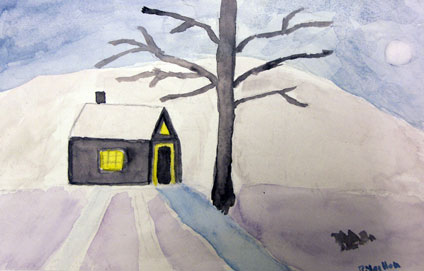
Watercolor painting by
Rita Murphy
Rita Murphy's watercolor learning experience:
Before you can start to prepare a greeting card, you need to secure the supplies. This means a trip to either an art supply store, Staples, or a craft store. On our way home from class last Saturday, November 1st, we stopped in the Somerville mall to shop for the supplies. The supplies needed are watercolor paper, envelopes and drafting tape. Yong suggested getting the tape at Staples so we went to Staples and we were able to make the purchase. Now for the envelopes and paper. It was suggested in class that you do not need to buy paper as you can cut the paper to fit the envelope. All that would be needed would be envelopes. Staples only had letter size envelopes not the kind used for sending a greeting card.
Next, we went to AC Moore. What a stroke of luck! We were able to purchase Strathmore Watercolor Cards and envelopes 140 lb. watercolor. Since there were ten cards and envelopes in the package, we decided to split the cost. Five cards are required so this made a perfect match. This means no cutting of paper since the size of the card is determined by the size of the envelope (envelope should be an invitation side per instructions in the web-site demonstration by Mary Churchill.
Now we are ready to begin drawing. First, you need a work station (hard cardboard glued together, I used three card boards). Then you want to with a ruler make a border 1/4" around the card. Write your greeting on the inside of the card. Doing this step helps to insure that your spelling is correct before painting and then noticing that you misspelled a word. Next tape the card to the work station putting the tape onto the border. Choosing your composition and then drawing it onto the paper should not be rushed. Quality time spent will enhance the picture. Plan what you want to include from the reference and what you want to eliminate.
Once the drawing is completed, you are ready to paint. Mary Churchill recommends not wetting the paper first as her paints are wet. I did wet the paper first and did not experience any problem. My first drawings are of my twin daughters playing in the snow. Of course, I did not paint the snow, left it white. In class, I learned that snow has colors, tones of gray. Did the best I could to add this dimension to the background. Heard in class that next week in class a technique will be demonstrated showing how to paint snow. I am really looking forward to learning how this is done.
Feel that I am making progress. Look forward to a time in my life (perhaps this summer) when I can enjoy the watercolor painting lessons learned.
